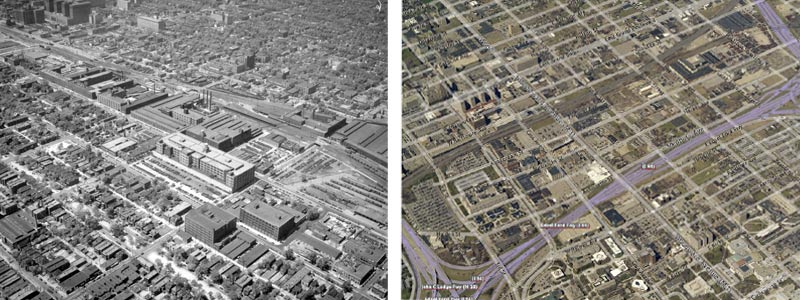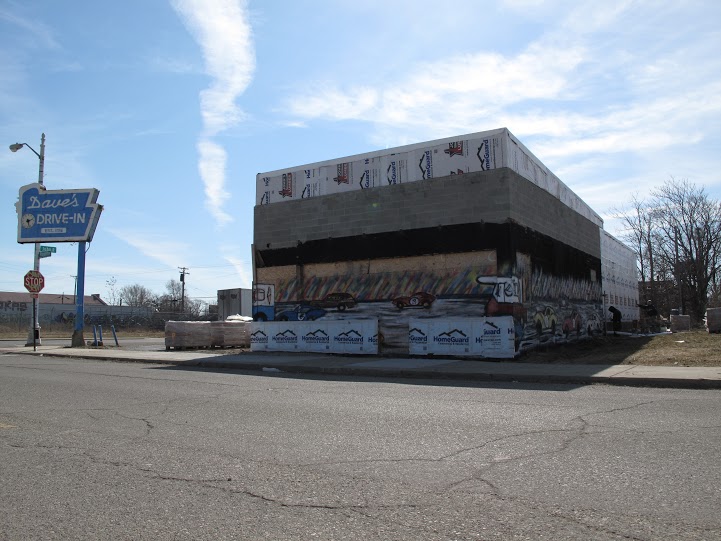Detroit’s next hot neighborhood is hiding in plain sight
 LEFT: A view of a densely packed Milwaukee Junction in 1949. The General Motors building is at upper left; the Fisher Body plant is the white building in the photo's center. (Courtesy DTE Energy) RIGHT: A contemporary view of Milwaukee Junction. Most activity is taking place in the district boarded on the west by Woodward Avenue, on the north by East Grand Boulevard, on the south by the Ford Freeway and the east by the Chrysler Freeway. (Courtesy photo copyright Pictometry International Corp.; used with permission.) Click photo to enlarge.
LEFT: A view of a densely packed Milwaukee Junction in 1949. The General Motors building is at upper left; the Fisher Body plant is the white building in the photo's center. (Courtesy DTE Energy) RIGHT: A contemporary view of Milwaukee Junction. Most activity is taking place in the district boarded on the west by Woodward Avenue, on the north by East Grand Boulevard, on the south by the Ford Freeway and the east by the Chrysler Freeway. (Courtesy photo copyright Pictometry International Corp.; used with permission.) Click photo to enlarge.
On East Milwaukee Avenue in central Detroit, Logan Siegel lives in a 126-year-old building with rust-colored brick that has been rehabbed and converted into nine condos owned by a diverse group of professionals. The value of the property has tripled in the past five years.
The surrounding landscape is foreboding, though: Structures that are collapsing upon themselves, wildly overgrown vacant lots, illegal dumping, glass-strewn roads and ubiquitous graffiti. The two-story building across from Siegel’s home is boarded up; to the east is a DTE Energy facility surrounded by an 18-foot cement wall topped with razor wire. It looks like a maximum security prison.
Despite the raw surroundings, Siegel has met many people in the past three years who are impatient to move in.
“Just about every time that I’m working outside my building, people stop by, sometimes a couple times a day, just asking if units are available to rent or buy,” he said.
“When you tell them there’s nothing available, they get very upset because there is nothing in the area.”
Siegel’s neighborhood is named Milwaukee Junction, once one of the world’s most productive industrial zones, the place where Henry Ford began experimenting with the Model T and the assembly line. It’s a sprawling area around the I-75/I-94 interchange that is old and beat up and exists mostly off the radar of local media and metro area residents.
While its dynamic past is gradually forgotten, Milwaukee Junction’s immediate future seems increasingly clear: It appears to be Detroit’s next hot neighborhood.
Buying up properties
The Junction is not considered part of “Greater Downtown Detroit” – the 7.2-square-mile slice of the city that has seen significant development in recent years. The neighborhood is such a non-entity that its boundaries are often confused with those of the North End, New Center and Midtown.
Shaped like a sideways T, Milwaukee Junction touches Woodward Avenue to the west, runs east along East Grand Boulevard, north past Holbrook and south to East Warren. Most of the new real-estate activity appears to be taking place within its western wing, between Woodward and I-75.
As Siegel’s encounters suggest, interest in the neighborhood is growing, and it’s not just prospective residents who are paying attention.
Milwaukee Junction is also quietly attracting real-estate buyers ‒ some of them young ‒ who are planning the kind of housing and 21st-Century developments that have drawn young people and businesses to Midtown, downtown, Corktown, Eastern Market and Woodbridge.
While the land purchases are real, many of the projects are still ideas that remain in various stages of planning. They include condos, apartments, a bar, restaurant, art gallery and spaces for work and events.
12 signs of growing interest in Milwaukee Junction
Even Midtown Detroit Inc., the non-profit planning organization that has catalyzed development north of downtown, has jumped into Milwaukee Junction, providing small grants to people behind two projects to help them close their deals.
“There are lots of people looking to do things,” Susan Mosey, Midtown Detroit Inc.’s executive director, said. “It’s starting to pick up. It’s about five years behind what’s happening in Midtown, but it’s starting to get some traction.”
One move that turned heads among developers took place this past July when Jordan Wolfe, a well known Detroit entrepreneur and co-owner of the renovated Claridge House Apartments on Washington Boulevard, purchased, with partners, the Chap Lofts condos on E. Grand Boulevard.
The neighborhood also is luring small, young entrepreneurs, such as Alex Pereira, a 35-year-old Bolivian-born real estate developer who received his MBA from the University of Michigan a year ago. He sold properties he owned in the western suburbs to concentrate on doing deals in Detroit. He paid $25,000 for a derelict residential building on the Edsel Ford Freeway service drive that he’s slowly converting to a six-unit condo.
“We’re going to see things really happen here in the next three to five years,” Pereira said.
Dave Biskner, president of the board of directors of the Friends of Milwaukee Junction, said in the most recent Wayne County Tax Foreclosure Auction, all three dozen Junction properties were sold ‒ the first time that had happened.
“I think that’s an indication of growing interest,” Biskner said.
Industrial powerhouse
For people looking for industrial chic, Milwaukee Junction might be the Motor City’s ultimate destination.
The neighborhood was the cradle of Detroit’s heavy manufacturing and became one of the most important concentrations of industry in the world. The factories – some of them colossal facilities – arose around the tangle of railroad tracks that included the Detroit and Milwaukee line that gave the neighborhood its name in the early years of the automobile age. At its peak in the 1940s, some 33,000 people worked in Milwaukee Junction, and there were 33 heavy manufacturing plants.
Henry Ford opened a factory on Piquette Avenue and Beaubien in 1904, and began producing Model T’s and fiddling with the assembly line before moving north to Highland Park, where his products and methods became world famous. The Ford Piquette Area Plant is now a museum and national historic site that has become a favorite among young metro Detroiters: It’s booked for weddings on many weekends this summer.
“We’ve even had three proposals” in the museum, said Dick Rubens, a longtime volunteer.
While a shadow of its former self, Milwaukee Junction today is both an industrial necropolis and a functioning manufacturing district that turns out products from artificial limbs to pipes to fenders.
There is a small amount of housing, and the district has a growing artistic component.
Junction leaders have encouraged outdoor art and murals, including a 6,000-square-foot image of a pouncing tiger by the internationally renowned Australian artist Dave (MEGGS) Hooke on the side of a building at Russell and Trombly. “RISE UP!!” the mural proclaims, a message Hooke has said he aimed at Detroiters.
 A 6,000-square-foot mural at Russell and Trombly streets by the Australian artist Dave (MEGGS) Hooke dwarfs a man standing on the sidewalk. (Courtesy photo by Sal Rodriguez) Click to enlarge.
A 6,000-square-foot mural at Russell and Trombly streets by the Australian artist Dave (MEGGS) Hooke dwarfs a man standing on the sidewalk. (Courtesy photo by Sal Rodriguez) Click to enlarge.
At Brush and Baltimore, a group of artists and developers have founded the Baltimore Gallery - formerly the “Untitled Bottega” - an art space and performance area, and last year received a $100,000 grant from the Knight Foundation to create an outdoor theater and cultural hub in an adjacent abandoned property. There’s also discussion of a summer art and music festival around the Tangent Gallery, an art and event space on East Milwaukee.
Well positioned
Another distinctive feature of Milwaukee Junction is its 12 rail viaducts, which carry groaning, slow-moving trains and give the district a film-noir vibe. Hollywood has discovered the Junction: Crews shot the “Batman v. Superman” film last summer at five locations, Biskner said. His group is planning to launch a film office to help location scouts and publicize local businesses. Neighborhood organizers also plan to continue improving the viaducts with murals and other features this summer.
Friends of Milwaukee Junction does not track investment in the area, but Bridge identified several projects and transactions that suggest the neighborhood is on the cusp of change.
Part of the reason for the upsurge in interest in Milwaukee Junction properties is the area’s impressive neighbors: Within a short walk are Wayne State University, Techtown, Detroit’s Amtrak station, the Fisher Building, WSU’s new $93 million Biomedical Research Building and the College for Creative Study’s Taubman Center, the 760,000-square-foot creative hive that General Motors Corporation vacated in 1999.
The Wayne State Police Department is a block from the Junction’s western boundary along Woodward Avenue; its officers have helped create a cocoon of security around Midtown. They also answer calls in Milwaukee Junction, though Chief Anthony Holt said the department doesn’t receive many.
Another feature that developers say has played a major role in spurring activity is the M-1 rail project, the 3.3-mile streetcar line that will run along Woodward from downtown to Grand Boulevard. M-1’s three northernmost stops will sit astride Milwaukee Junction’s western limit.
“We’re two blocks from all kinds of things,” said Peter Allen, a member of a group that’s planning an apartment development called Baltimore Station at Woodward and East Baltimore. “We couldn’t be in a better position.”
 An artist's drawing of Baltimore Station, a proposed apartment project at East Baltimore and Woodward. (Courtesy photo by Pivot Real Estate Services LLC) Click to enlarge.
An artist's drawing of Baltimore Station, a proposed apartment project at East Baltimore and Woodward. (Courtesy photo by Pivot Real Estate Services LLC) Click to enlarge.
Allen is an Ann Arbor developer who teaches at the University of Michigan’s business school. Last year, three students doing a semester project on real estate developments located, with the help of Midtown’s Mosey, an abandoned restaurant and event space on that corner.
The students planned an apartment development for the class, then asked Allen to join them to carry out the project in real life. They formed an LLC , entered into an agreement to buy the property from the city of Detroit for $137,000 and plan to raise close to $2 million to build seven to 14 apartments in the two-story building. They will even add a third floor.
“We’re doing our due diligence and expect to close in the next 90 days,” Allen said.
Will development benefit average Detroiters?
Milwaukee Junction presents challenges for developers beyond its gritty ambience. People involved in the area say decades-old ground pollution can hinder the permitting process, and the neighborhood’s large factories are not as easily converted into housing as, say, an unused apartment building in Midtown.
While its name is more than a century old, Milwaukee Junction does not have built-in recognition like the kind that has benefitted better-known areas such as Corktown or Eastern Market, nor can it boast a prominent booster, such as Midtown’s Mosey or downtown’s Dan Gilbert, and, in years past, Peter Karmanos and Mike Ilitch.
Developments planned for Milwaukee Junction, while exciting for a beleaguered city that recently exited bankruptcy, also could reinforce the notion among critics in outer neighborhoods that virtually all downtown area construction in Detroit benefits young, predominantly white people who want exposed brick walls in their homes and craft-beer joints on the corner.
Adding to that notion, there appears to be little minority involvement in the development of Milwaukee Junction, a sore point for some observers in a city that is about 83 percent African American.
George Jackson, who ran the Detroit Economic Growth Corporation for 12 years, said one major challenge is the wealth gap between white and black Americans.
“For a lot of the young white people who are doing these things so visibly, one factor is, a lot of them get money from non-traditional sources, like their parents,” said Jackson, who is African American.
To overcome that issue, Jackson suggested foundations could play a role by assembling a seed-money fund for minority entrepreneurs. He said African Americans themselves also have to get better at joining forces and pooling money for projects.
“To me, that is long overdue,” he said.
James Feagin, an African-American real estate developer and consultant who is part of a group developing property in Milwaukee Junction, added that, even if you have money, banks often are reluctant to make loans to people without a track record.
Unless you have some way to provide capital and allow risks for people who haven’t had it, “You’re just going to have a system that facilitates the folks who have a track record and capital for getting things done,” Feagin said.
Techno in the Fisher body plant?
The landowners and would-be owners in Milwaukee Junction include familiar local names, unknowns and at least one global celebrity.
Dennis Kefallinos, a well-known Detroit landlord, says he soon will begin to build 40 loft-style apartments inside the crumbling Fairmont Creamery on E. Milwaukee that he has owned for several years.
In November, Kefallinos, who also owns the Milwaukee Park Lofts in Milwaukee Junction and the nearby Russell Industrial Center, bought the three-story Perlex Building on E. Grand Boulevard, and says he is considering converting it to residences, though not immediately.
Bucharest Grill owner Bogdan Tarasov plans to open his third Detroit location this summer for Romanian shawarma and sausages inside an old drive-in restaurant at John R and Piquette, down the street from the Model T museum.
 Workers are rehabbing the former Dave's Drive-In on Piquette for Bucharest Grill's third location in Detroit. It is scheduled to open by summer. (Bridge photo by Bill McGraw) Click to enlarge.
Workers are rehabbing the former Dave's Drive-In on Piquette for Bucharest Grill's third location in Detroit. It is scheduled to open by summer. (Bridge photo by Bill McGraw) Click to enlarge.
Even the massive and disintegrating Fisher Body plant on Piquette has drawn renewed attention. This past fall, Germany-based Dimitri Hegemann – who founded Berlin’s Tresor, one of the world’s most famous techno-music clubs – was the subject of media reports that said he is eyeing the old factory for a club in Detroit.
Hegemann’s Detroit associate, local music journalist Walter Wasacz, told Bridge that Hegemann remains focused on creating a techno club in the city, and he has formed a partnership with Underground Resistance, the Detroit techno group, whose headquarters is on East Grand Boulevard.
But Wasacz said Hegemann is more generally interested in creating a larger community project that could include such elements as an organic farm, innovation center and neighborhood marketplace that might be located in Milwaukee Junction or elsewhere in Detroit.
“If we can make the Fisher plant work it would be a miracle,” Wasacz said.
Home sweet home
Siegel, a 31-year-old filmmaker, has lived on East Milwaukee since 2004. He’s bullish on Milwaukee Junction, pleased about his home’s diverse residents, proud of the cherry-blossom trees in front of the building and happy the property’s value has increased.
He was also delighted to learn the deteriorating, boarded-up building across the street could have a future.
Carlo Liburdi, 34, a University of Detroit-Mercy trained architect and real estate developer who lives in Brooklyn, N.Y., controls an interest in the property and said his goal is to build several residential units and a bar in the corner of the building, just steps from the intersection of Milwaukee and Beaubien.
Liburdi, who grew up in Troy, said he and his partners “tend to like where the neighborhood’s going.”
Said Siegel: “I can’t imagine living anywhere else.”
See what new members are saying about why they donated to Bridge Michigan:
- “In order for this information to be accurate and unbiased it must be underwritten by its readers, not by special interests.” - Larry S.
- “Not many other media sources report on the topics Bridge does.” - Susan B.
- “Your journalism is outstanding and rare these days.” - Mark S.
If you want to ensure the future of nonpartisan, nonprofit Michigan journalism, please become a member today. You, too, will be asked why you donated and maybe we'll feature your quote next time!

